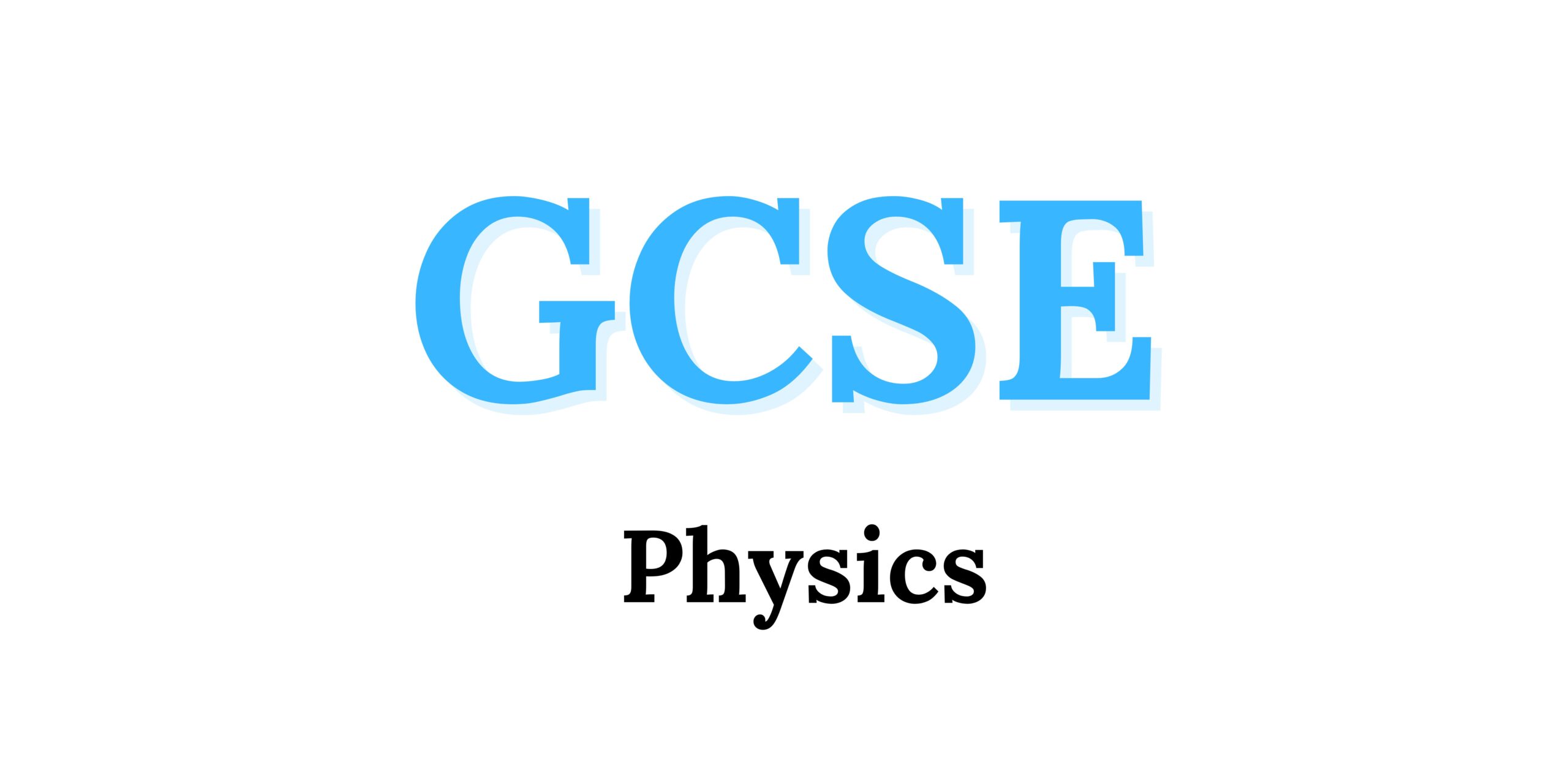
Overview of AQA GCSE Physics qualifications
Subject content:
1. Energy
The 19th-century concept of energy explained steam engine output and was later applied to heat engines, chemical reactions, and biological systems. Today, reducing energy usage is crucial due to fossil fuel limits and global warming.
| Scope of study | Content |
|---|---|
| Energy changes in a system, and the ways energy is stored before and after such changes | • Energy stores and systems • Changes in energy. Formulas: • Energy changes in systems. Formula: • Power. Formulas: |
| Conservation and dissipation of energy | • Energy transfers in a system • Efficiency: |
| National and global energy resources | • Sources of energy • Renewable and non-renewable resources • Types of energy use in transportation, electricity, and heating • The environmental impacts of different resources • Political, social or economic factors in solving environmental problems |
2. Electricity
Electric charge is key to electrical circuits. Conductors, semiconductors, and insulators differ in microstructure, impacting design. Mains power and batteries supply electricity. Electromagnetism was developed in the 19th century. Power plants age and new ones are needed to meet growing demand. Finding a sustainable energy mix is crucial.
| Scope of study | Content |
|---|---|
| Current, potential difference and resistance | • Standard circuit diagram symbols • Electrical charge and current: [ Q = I t ]. • Current, resistance and potential difference: [ V = I R ]. • Resistors |
| Series and parallel circuits | • Construct and analyze series and parallel circuits • Distinguish between series and parallel circuits • Effect of resistors on resistance in series and parallel circuits • Calculate current, potential difference and resistance in series circuits |
| Domestic uses and safety | • Direct and alternating potential difference • Mains electricity |
| Energy transfers | • Power. Formulas: [ P = V I ] and [ P = I2R ]. • Energy transfers in everyday appliances. Formulas: [E = P t], [E = Q V]. • The National Grid |
| Static electricity | • Static charge • Electric fields |
3. Particle model of matter
The particle model predicts the behavior of solids, liquids, and gases, with applications in everyday life and engineering, such as designing submarines and spacecraft. It also explains challenges like making tea at high altitudes.
| Scope of study | Content |
|---|---|
| Changes of state and the particle model | • Density of materials. Formula: • Changes of state |
| Internal energy and energy transfers | • Internal energy • Temperature changes in a system and specific heat capacity. Formula: [ ∆ E = m c ∆ θ]. • Changes of state and specific latent heat. Formula: [ E = m L ]. |
| Particle model and pressure | • Particle motion in gases • Pressure in gases. Formula: [ p V = constant ]. • Increasing the pressure of a gas |
4. Atomic structure
Ionising radiation, discovered over a century ago, is hazardous but useful. It took decades to understand atomic structure and nuclear forces. Early researchers faced risks, leading to protective rules. Today, radioactivity is used in medicine, industry, agriculture, and power generation.
| Scope of study | Content |
|---|---|
| Atoms and isotopes | • The structure of an atom • Mass number, atomic number and isotopes • The development of the model of the atom |
| Atoms and nuclear radiation | • Radioactive decay and nuclear radiation • Nuclear equations • Half-lives and the random nature of radioactive decay • Radioactive contamination |
| Hazards and uses of radioactive emissions and of background radiation | • Background radiation • Different half-lives of radioactive isotopes • Uses of nuclear radiation |
| Nuclear fission and fusion | • Nuclear fission • Nuclear fusion |
5. Forces
Engineers use force analysis to design diverse machines, from road bridges to atomic force microscopes. This method is applied to mechanical devices, including the latest advancements in artificial limbs to enable movement.
| Scope of study | Content |
|---|---|
| Forces and their interactions | • Scalar and vector quantities • Contact and non-contact forces • Gravity. Formula: [ W = m g ]. • Resultant forces |
| Work done and energy transfer | • Work done. Formula: [ W = F s ]. • The transfer of energy in doing work • Conversion of newton meters and joules |
| Forces and elasticity | • Understanding forces in stretching, bending, and compressing objects • Elastic and inelastic deformation • Energy and Work |
| Moments, levers and gears | • Rotation by Forces. Moment of force: [ M = F d ] • Balanced Moments • Levers and Gears |
| Pressure and pressure differences in fluids | • Pressure in a fluid • Atmospheric pressure |
| Describing motion along a line | • Distance and displacement • Speed • Velocity • The distance–time relationship • Acceleration |
| Forces, accelerations and Newton’s Laws of motion | • Newton’s First Law • Newton’s Second Law • Newton’s Third Law |
| Forces and braking | • Stopping distance • Reaction time • Factors affecting braking distance |
| Momentum | • Momentum is a property of moving objects: p = m v. • Conservation of momentum • Changes in momentum |
6. Waves
Waves are crucial in natural and man-made systems, transferring energy and information. Understanding mechanical waves is vital for designing safe structures like bridges and performance halls. Electromagnetic waves are essential in modern technologies, including imaging and communication systems.
| Scope of study | Content |
|---|---|
| Waves in air, fluids and solids | • Transverse and longitudinal waves • Properties of waves • Reflection of waves • Sound waves (HT only) • Waves for detection and exploration (HT only) |
| Electromagnetic waves | • Types of electromagnetic waves • Properties of electromagnetic waves • Uses and applications of electromagnetic waves • Lenses • Visible light |
| Black body radiation | • Emission and absorption of infrared radiation • Perfect black bodies and radiation |
7. Magnetism and electromagnetism
Magnetism and electromagnetism are essential in many devices. Engineers use the principles that a moving magnet in a coil generates electric current and that current around a magnet creates movement. These effects are key in control and communication systems.
| Scope of study | Content |
|---|---|
| Permanent and induced magnetism, magnetic forces and fields | • Poles of a magnet • Magnetic fields |
| The motor effect | • Electromagnetism • Fleming’s left-hand rule (HT only) • Electric motors (HT only) • Loudspeakers (HT only) |
| Induced potential, transformers and the National Grid (HT only) | • Induced potential (HT only) • Uses of the generator effect (HT only) • Microphones (HT only) • Transformers (HT only) |
8. Space physics
Space physics explores fundamental questions about our universe’s origins and structure. Recent discoveries include “dark matter,” which doesn’t emit electromagnetic radiation but holds galaxies together. Another mystery is the accelerating expansion of the universe. These findings continue to shape our understanding of the cosmos.
| Scope of study | Content |
|---|---|
| Solar system; stability of orbital motions; satellites | • Our solar system • The life cycle of a star • Orbital motion, natural and artificial satellites |
| Red-shift | • The qualitative redshift of light from distant galaxies • Expanding Universe • Big Bang Theory |
For detailed information about the General Certificate of Secondary Education (GCSE) and how it can shape your academic future, click here to explore: GCSE Information
Required practical activities
1. Determine the specific heat capacity of materials by linking energy changes to temperature increases.
2. Test and compare the effectiveness of different thermal insulators and factors affecting their properties.
3. Investigate factors affecting electrical resistance using circuit diagrams, including wire length and resistor combinations.
4. Measure the current-voltage (I–V) characteristics of filament lamps, diodes, and resistors.
5. Determine densities of solids and liquids using appropriate measurement techniques and tools.
6. Explore the relationship between force and extension for a spring.
7. Examine how force and mass affect the acceleration of an object.
8. Measure frequency, wavelength, and speed of waves in different media.
9. Investigate light reflection on various surfaces and refraction through different substances.
10. Study how surface properties affect the absorption and emission of infrared radiation.
Assessment
| Type of assessment | Content | Final score | Weighting of final grade |
|---|---|---|---|
| Paper 1: Multiple choice, structured, closed short answer and open response. | Topics 1-4: Energy; Electricity; Particle model of matter; and Atomic structure. | 100 marks | 50% |
| Paper 2: Multiple choice, structured, closed short answer and open response. | Topics 5-8: Forces; Waves; Magnetism and electromagnetism; and Space physics. Questions in Assignment 2 may draw on an understanding of energy change and transfer in heating, mechanical and electrical work, and the concept of conservation of energy from Energy and Electricity. | 100 marks | 50% |
Assessment objective weightings for GCSE Physics
Assessment Objectives:
AO1: Demonstrate knowledge of scientific concepts, techniques, and procedures.
AO2: Apply scientific knowledge and inquiry techniques.
AO3: Analyze and interpret data, make judgments, and refine experimental methods.
| Assessment objectives (AOs)* | Component weightings Paper 1 (%) | Component weightings Paper 2 (%) | Overall weighting (approx %) |
|---|---|---|---|
| AO1 | 37‒43 | 37‒43 | 40 |
| AO2 | 37‒43 | 37‒43 | 40 |
| AO3 | 17‒23 | 17‒23 | 20 |
| Overall weighting of components | 50 | 50 | 100 |
Assessment weightings
The marks on the papers will be scaled according to the weighting of each component. Students’ final marks will be the sum of these scaled marks. Grade boundaries will be determined based on this total scaled mark. The scaling and total scaled marks are detailed in the table below.
| Component | Maximum raw mark | Scaling factor | Maximum scaled mark |
|---|---|---|---|
| Paper 1 | 100 | x1 | 100 |
| Paper 2 | 100 | x1 | 100 |
| Total scaled mark: | 200 |
If you need help with Physics or any other subject, our tutors are ready to support you on your academic journey. Don’t miss your chance to succeed—take a trial lesson today!











